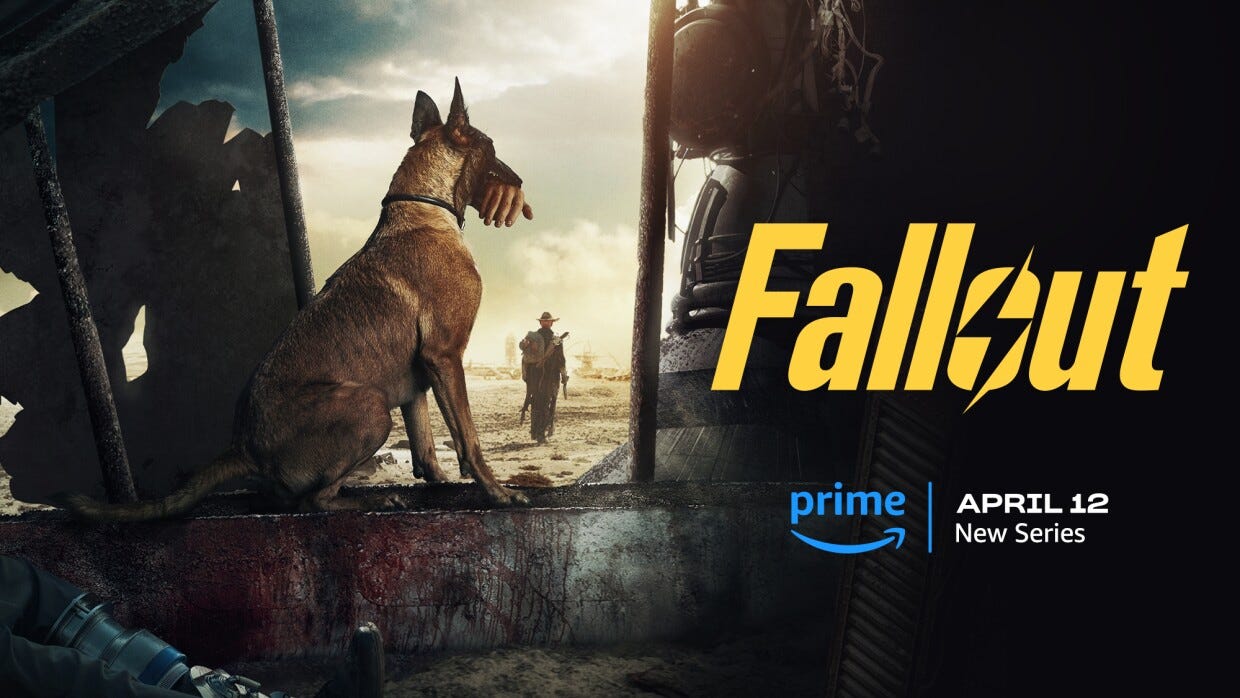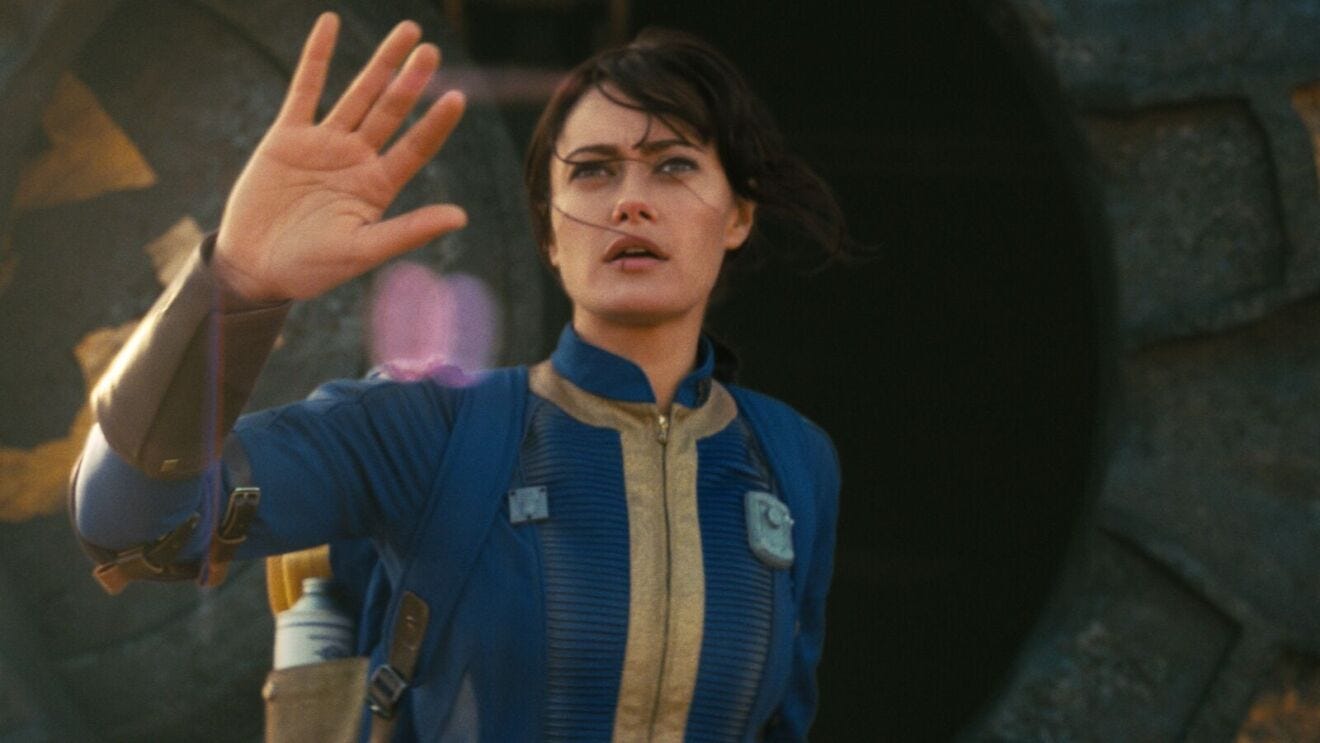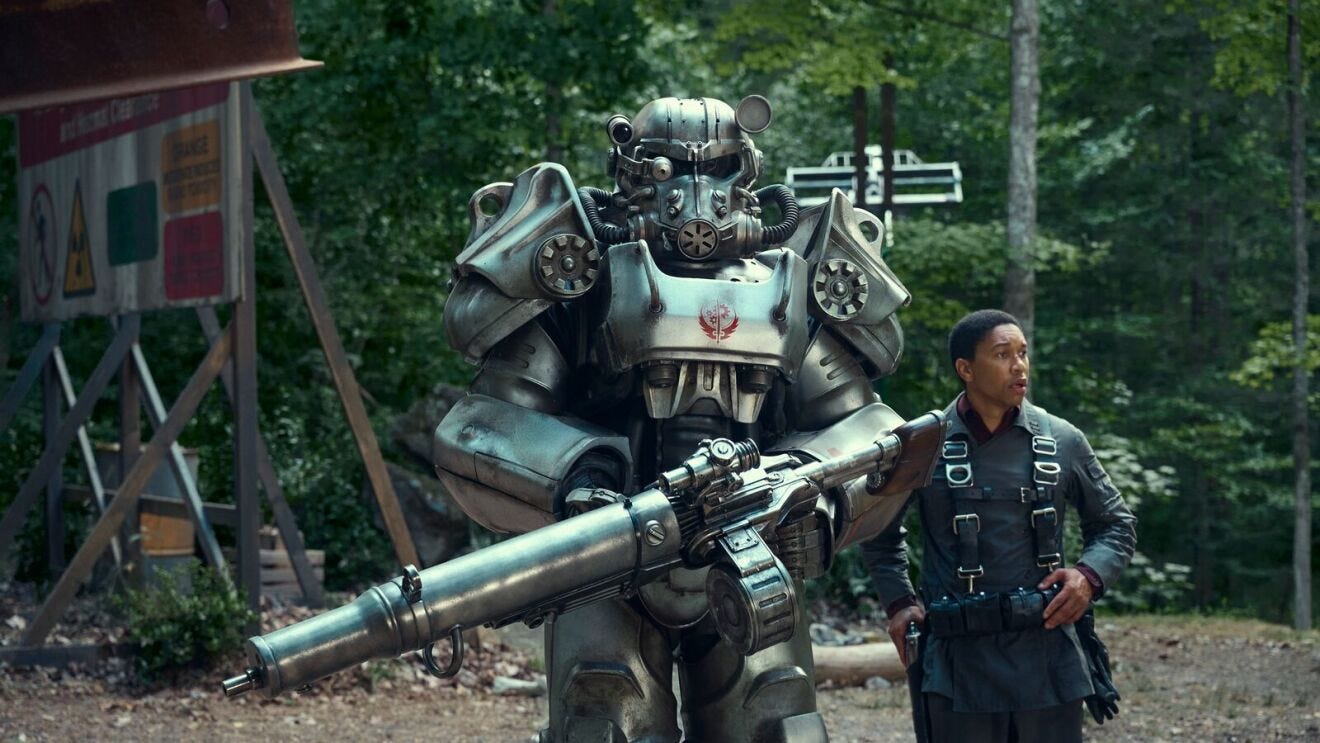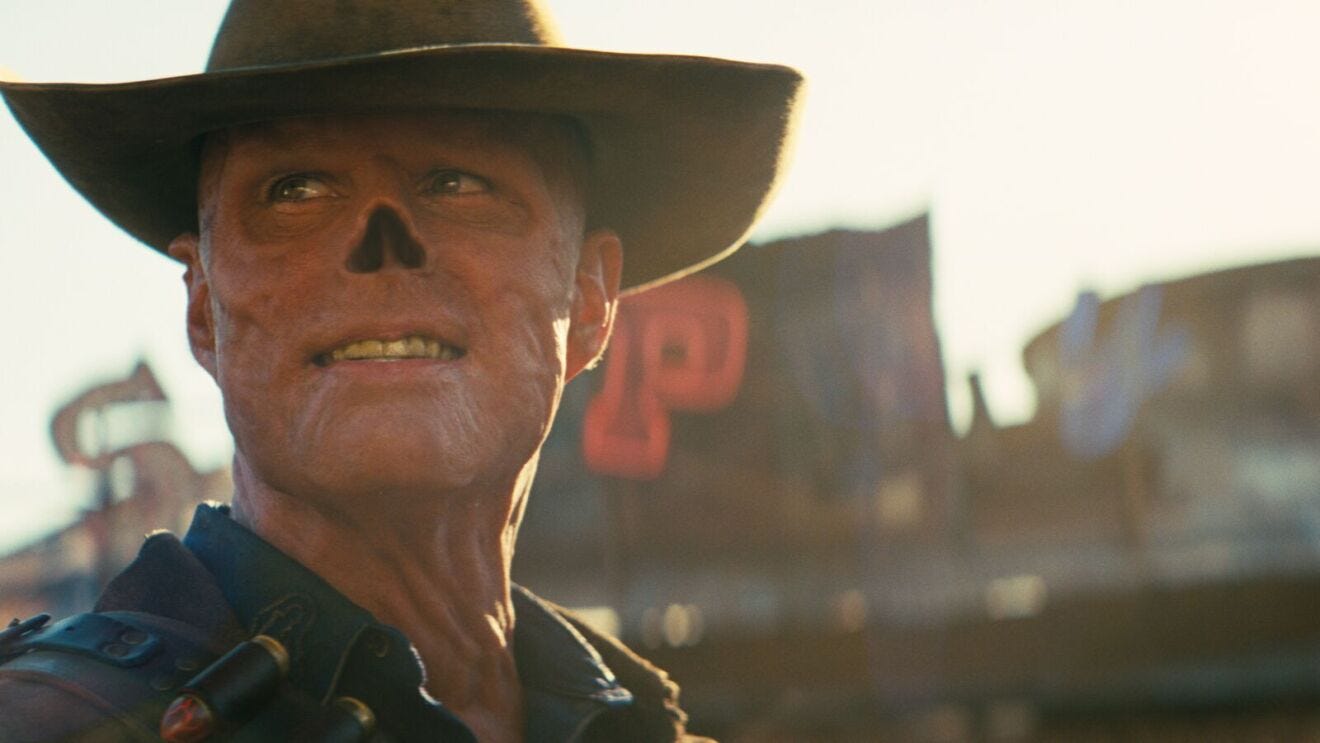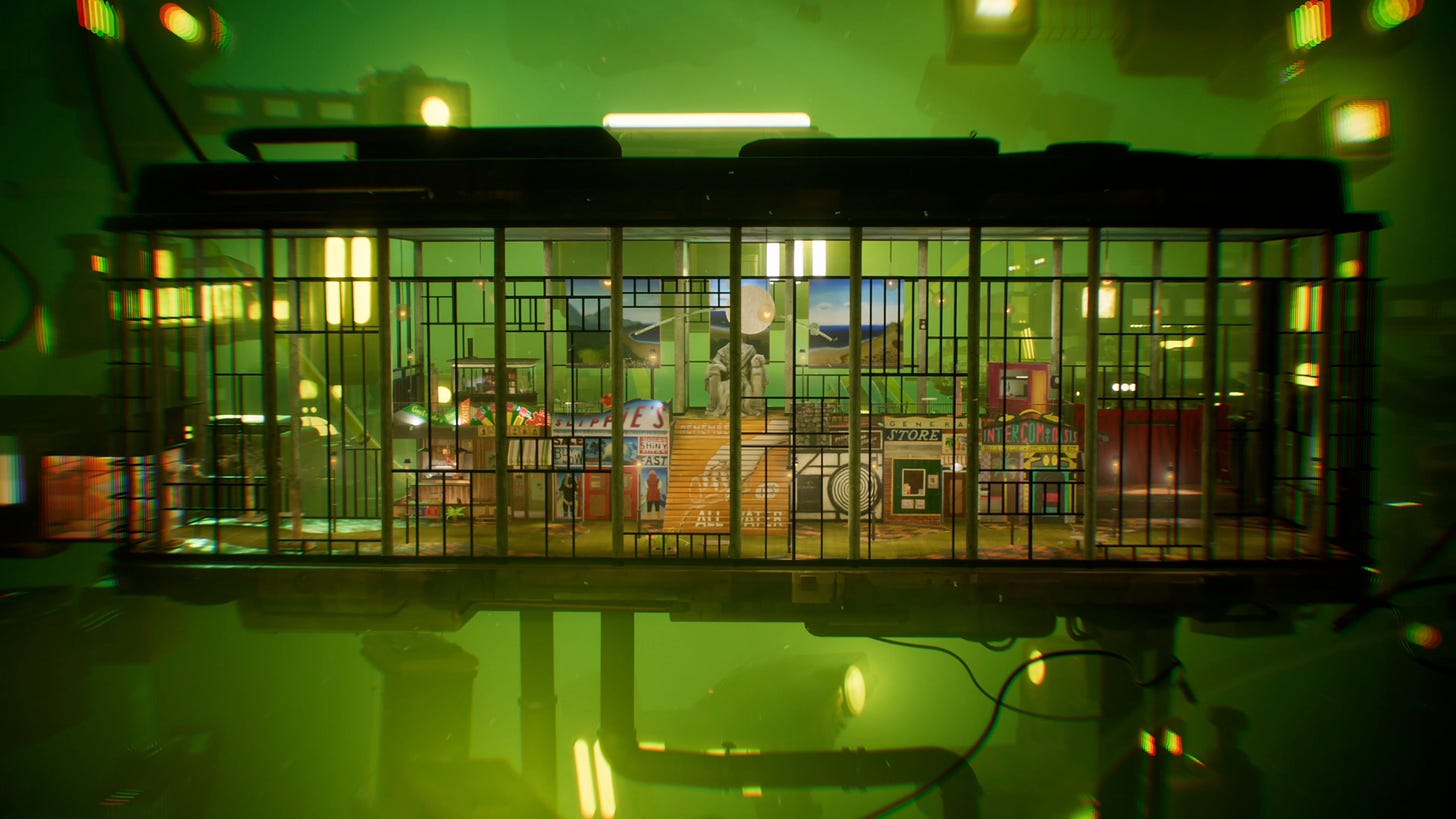Fallout on Prime Video and a side of Halibut
A breakdown of why the show transcends the title of 'great videogame adaptation'
Every so often (extremely often these days, if I do say so myself), studio execs decide to greenlight a TV show or film based on a videogame and it sends journalists of all hues scampering to draw up lists:
“Best videogame films ever”
“Before you watch [some upcoming film], check out these 10 videogame adaptations”
“17 videogame shows/films you must watch before you die”
“5 times videogame-based films made us cry”
“Videogame movies so good the internet can’t keep calm”
“Most bussin’ 🔥 videogame glow-ups fr deadass no cap”
And so on. You get the idea. That said, I’m no different: While I may not necessarily commit these thoughts to text, I do indulge in nostalgia exercises about the adaptations I enjoyed most, and why I enjoyed them. I extol the virtues of Wreck-It Ralph, which although not based on an actual videogame, captures the essence of so many diverse videogame characters in such a charming manner. I applaud Pixels in the same vein. I scoff at Uncharted’s blandness and the sheer distance by which it missed the appeal and magic of the games. I hail the spirit and perseverance (although definitely not the filmmaking) of Uwe Boll. I argue that a vast majority of The Last of Us — barring one episode, that is — was just pulled off the games and didn’t really require that much creativity or reinterpretation. I question the reason for Wing Commander and Rampage’s existence. And then I fondly recall that one videogame adaptation that occupies a special place in my heart.
Doom was not a great film. That is to say it wasn’t even a particularly good film — for all intents and purposes, it was a Dwayne Johnson vehicle from back when he was still going as ‘The Rock’ outside of the WWE. Hell, I’m not even all that fond of the Doom games. Or even the idea of first-person shooters. For what it’s worth, I don’t mind the concept of a first-person perspective in games when it is used in an RPG (take for instance Cyberpunk 2077, The Outer Worlds, Deus Ex and so on). But if the purpose of the game is just shooting computer-generated or human-controlled characters, then I tend to switch off pretty damn quickly.
Back to Doom now. The story was quite uninteresting when it wasn’t busy revelling in cliché and the eye-rollingly obvious. The special effects were average. The cinematography was of a school project level in some sequences. The acting was poor and the likes of Rosamund Pike, Karl Urban and DeObia Oparei were wasted on this. But then, with the abject quality of writing on offer (“I’m not supposed to die”), it’s no surprise. But when you put all these elements together and sprinkle over them the iconic first-person shooter segment (the big payoff towards the film’s end conveniently available here if you don’t have time to sit through around 100 minutes of Dwayne), it turns into this remarkable gem I can revisit at any time. And get a laugh or two (intentional or otherwise) while I’m at it.
That’s my cue to start talking about Fallout, the streaming series based on the eponymous games, that has almost nothing in common with Doom. It is well-written, well-acted, smartly-conceptualised and wonderfully shot. What it does have in common with Doom is that it is far greater than the sum of its parts. And that it is hugely entertaining.
I would be lying through my teeth if I claimed by any stretch of the word to be a ‘fan’ of the Fallout videogame series, because it’s not so much that I don’t enjoy Bethesda Game Studios games, they’re just not my favourites. There’s this indescribable fatigue that usually sets in when I consider firing up one of the studio’s open-world games. The Elder Scrolls III: Morrowind and Starfield are the only ones on which I’ve lavished a significant (by which I mean upward of 100 hours) amount of time. And now please take the poll below (it’s not an ad, Anirudh).
The paragraph above notwithstanding, I have dabbled with the Fallout series in measured bursts, with a chunk of time reserved in advance for the Fallout 4 current-gen update set to drop next week. So with my credibility (or vague familiarity with the material, at the very least) established, let’s get on with the show.
Created by Graham Wagner and Geneva Robertson-Dworet and produced by… a number of people including Jonathon Nolan (who also directed three episodes of the first season) the Prime Video series Fallout landed on TVs, laptops, tablets, mobiles and wherever else people stream content on April 10. In equal parts buoyed by the television series treatment of The Last of Us, and disheartened by that of Halo (which I never did complete, come to think of it), I was caught in two minds about investing time in Fallout. The utterly batshit and hilarious Twisted Metal tipped the scales and gave me hope. And the trailer then reinforced that hope.
What struck me in the first half of the trailer above was how well the creators of the show had nailed the atompunk1 (feel free to visit the footnotes where I’ll be laying down some theory) aesthetic of the games. The rest of the trailer was a montage of interesting yet disjointed things that left me curious enough to check out the first episode. At around 70 minutes, the series premier ‘The End’ is a slick, action-packed, gory and pulsating ride that serves to introduce us to the key players and trio of protagonists — Lucy MacLean, Cooper Howard aka The Ghoul and Brotherhood of Steel member Maximus — and lay down the narrative groundwork for each of them.
In films and TV shows that juggle multiple leads, it’s common to find the main characters following independent story arcs that intersect at or just before the climax of the piece. It is therefore extremely refreshing to find that this isn’t the case in Fallout. In fact, it’s in the second episode that the trio first crosses paths in Filly — a town that distinctly gave off Megaton vibes. For the uninitiated, Megaton is a town in Fallout 3 (maybe it pops up in some of the other games too, I don’t know) that is built around a crater with an undetonated atomic device inside it.
I’ll spare you the episode-by-episode recap, and state that I recently completed what I hope will be the first of a handful of seasons, and found it riveting and thoroughly entertaining. What’s more, while the show does have its lore, it doesn’t insist upon it — so you can enjoy it as a breezy binge-watch. However, it has a great deal of depth for those seeking to get into the nuts and bolts of each bit of scenery, probe whether or not it is canonical and investigate the direct/indirect links to games in the series.
I’ve always found myself enamoured more by adaptations that actually adapt content from one medium to another rather than just remaking it. To elaborate, it’s the difference between the third episode of The Last of Us and every other episode. The former feels like an adaptation, where the writers adapted the source material and added their own magic. The latter, on the other hand, was very much a copy-paste job story-wise. Don’t get me wrong, it made for great TV, but I’d seen it all before presented in almost exactly the same way.
What Fallout does to great effect is to situate an original story within a well-known universe and among all sorts of canonical goings-on. And in doing so, it is faithful to the videogame series without being overly deferential. Most importantly, like the games, it focuses on an exploration of such themes as war, survival, rebuilding society, and morality in a post-apocalyptic world — which are integral to the Fallout universe.
To elaborate, the show wonderfully captures the atompunk aesthetic of the games — including the retrofuturistic design and the desolate wasteland setting — and includes iconic elements from the games, such as the Ghouls, vaults and factions like the Brotherhood. The tone too is very consistent with that of the videogames, with dark humour and satire dripping from the show’s every pore, in its great balance of bleakness with levity.
Where it diverges greatly from the series is in its perspective and approach. The protagonist in the Fallout games is a blank slate and you colour them with your own decisions and cosmetic choices. The show has three protagonists, who are all original and fully fleshed-out characters with clearly drawn story arcs (unlike the games where you pick up the threads of various story arcs). And over the course of the series, we move back and forth from these three viewpoints — including in the same scene, most notably in the scene in Filly.
In so doing, the writers are given the creative freedom to really shine within the confines of an established universe. For me, this willingness to play with three decidedly different frames of reference and the ability to do justice to all of them is the show’s strongest attribute. Each individual story is great, but put together, Fallout is most certainly greater than the sum of its parts. Much like Doom, but for different reasons. But we’ve been through all that.
I believe Fallout transcends a large percentage of existing videogame adaptations because it stands up very well to scrutiny as an independent entity. In other words, it wouldn’t matter whether or not you knew there was a series of games that served as its basis. To call it a ‘videogame adaptation’ would , in my view, be rather reductive. The show is fantastic simply as a show and not a show based on something. And that’s why you need to go watch it.
In closing…
This week, I stumbled upon an absolutely delightful throwback to the golden age of point-and-click adventures — an era marked by such gems as the Monkey Island series, Grim Fandango, Full Throttle, Sam & Max, the Broken Sword games and so on. The throwback in question? Halibut Harold by German studio Slow Bros. Everything from the art style, the character models, the old-timey manner in which animations load up when you initiate an interaction and the background score has me entranced so far.
And the there’s the fascinating premise: Earth has reached the brink of uninhabitability. (Side note: Given the sheer zettabytes of content devoted to Earth’s destruction, we really should be taking the threat more seriously) Now in order to survive, a spacecraft known as the Fedora embarks on a quest to discover a new home for humanity. It lands on an aquatic planet that serves as the new habitat for our species. It is there that the ship is transformed into a makeshift underwater city and you, the player, essay the role of Harold Halibut, maintenance worker extraordinaire extremely ordinaire.
This charmingly quirky and hand-crafted game has been, I’m reliably informed, in the making for 14 years and finally released on April 16. I’ve been playing it on Game Pass ever since, although I do have an eye out for a physical edition (make it happen, Signature Edition Games and/or Limited Run Games). You can expect a deep-dive into the game next week (or perhaps the week after).
I was hoping to have a review ready in time for this edition of The Qun, but I underestimated the length of each Fallout episode and the amount of time I would spend on Stellar Blade. I can confirm that the review for the latter will be up on April 24, so keep an eye out for it. That’s about all I can say about it at this point, because you know, embargoes and such.
Atompunk is a retrofuturistic genre born from the Atomic Age's optimism and fears. It encapsulates the duality of hope and apprehension that defined the mid-20th Century. The genre depicts a future that is powered by atomic energy, the promise of technological marvels and space exploration. However, it is a world that also grapples with the shadow of nuclear annihilation.
This genre not only celebrates post-war technological advancements but also critically examines the ethical implications and the era's geopolitical tensions. The aesthetic of atompunk is characterised by sleek designs, and architecture and fashion that reflects the era's fascination with atomic motifs and space-age optimism. Bright, saturated colours and futuristic typography dominate its art style, capturing the period's spirit and its dreams of a utopian future.




